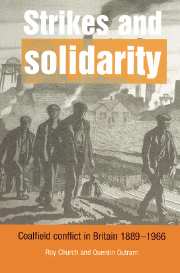Book contents
- Frontmatter
- Contents
- List of figures and tables
- Preface
- List of abbreviations
- 1 Interpreting coalfield conflict: focus and formulations
- 2 Tradition and modernity: the mining industry 1889–1940
- 3 Employers and workers: organizations and strategies
- 4 Employers and workers: ideologies, attitudes and political orientations
- 5 Configurations of strike activity
- 6 Strike participation and solidarity before 1912
- 7 Strikes, organization and consciousness in 1912 and after
- 8 Conflictual context? The ‘isolated mass’ revisited
- 9 Mining and modernity: size, sectionalism and solidarity
- 10 The foundations of strike propensity
- 11 Miners and management: agency and action
- 12 Industrial relations and strikes after nationalization
- 13 International perspectives
- 14 Myths and realities: strikes, solidarity and ‘militant miners’
- General appendix
- List of references
- Index
1 - Interpreting coalfield conflict: focus and formulations
Published online by Cambridge University Press: 04 December 2009
- Frontmatter
- Contents
- List of figures and tables
- Preface
- List of abbreviations
- 1 Interpreting coalfield conflict: focus and formulations
- 2 Tradition and modernity: the mining industry 1889–1940
- 3 Employers and workers: organizations and strategies
- 4 Employers and workers: ideologies, attitudes and political orientations
- 5 Configurations of strike activity
- 6 Strike participation and solidarity before 1912
- 7 Strikes, organization and consciousness in 1912 and after
- 8 Conflictual context? The ‘isolated mass’ revisited
- 9 Mining and modernity: size, sectionalism and solidarity
- 10 The foundations of strike propensity
- 11 Miners and management: agency and action
- 12 Industrial relations and strikes after nationalization
- 13 International perspectives
- 14 Myths and realities: strikes, solidarity and ‘militant miners’
- General appendix
- List of references
- Index
Summary
Mining strikes and ‘militant miners’: contemporary perceptions and empirical expositions
Miners are not averse to striking on slight pretext. They like to ‘play’ at intervals, and then return to scrabble harder in the pits, whence they can direct their thoughts with some contempt to the people who have to pass all their hours on the surface. The public takes no notice of these small disputes. They are not even reported in the papers, except by some short paragraph stating that 2,000 men have stopped work because a non-unionist has been discovered, or a foreman is disliked or the appointment of a checkweighman is questioned. The man in the street wonders why such a storm in a teacup should upset so many people, and possibly deems the stoppage to be the work of an ‘agitator’ or an unnecessary exhibition of strength. (Askwith 1920/1974: 201)
Of all classes of labour, he [the coalminer] is the most grasping and the most combative, the sturdiest fighter in the industrial field, always asking for more. (Bulman 1920: 2)
The miner not only works in the pit, he lives in the pit village, and all his immediate interests are concentrated at one point. … The miners' intense solidarity and loyalty to their unions is undoubtedly the result of conditions under which they work and live. … Their isolation ministers to their self-sufficiency and loyalty one to another. (Cole 1923: 7)
The British coalminer's reputation for militancy, exemplified in the observations quoted above by Askwith, a leading and experienced industrial conciliator, Bulman, a colliery director, and Cole, a scholar and a champion of labour, endured into the 1990s, when the dramatic decline in the coal industry was accompanied by a spectacular fall in the number of working miners.
Information
- Type
- Chapter
- Information
- Strikes and SolidarityCoalfield Conflict in Britain, 1889–1966, pp. 1 - 16Publisher: Cambridge University PressPrint publication year: 1998
